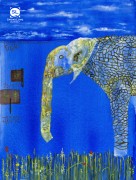I was struck right away by the sense that there are a lot of “things within things” in this story: from the start, a phone call places us inside two kitchens at once, the narrator is both alone and in the company of another person, there’s a woman inside a painting inside a roadshow inside a television inside a living room inside a house full of things. Is this layering something you discovered and fostered as you crafted the piece? Is it a condition you like to explore in your work in general?
I like this question because it describes a pattern I didn’t consciously create! Patterns in writing interest me—they reveal so much about the writer’s psychology.
This story was originally part of a collection I wrote for my undergraduate thesis; one of the comments made about my work during the defense was, “so much of your work takes place inside people’s heads.” I’m a pretty internal person and I have a habit of making my characters think like me. Layering is a way of emphasizing all the things that are going on below the surface; what we see isn’t always the whole picture.
Speaking of “the whole picture,” the story’s unusual title seems to point the reader to the likelihood that the vivid artwork at the heart of this piece is a real painting—and that we’re watching what might be a real episode of Antiques Roadshow. Is it important to you that your readers know whether that’s the case? Do you feel the story will have a different impact on readers who look the painting up and those who do not?
This piece is based on a real clip from Antiques Roadshow I stumbled upon accidentally. The painting was so striking I knew I had to write about it. I think of this story in part as an Antiques Roadshow ekphrasis, and using the painting’s title is a way to give credit to the original work. I used some of the dialogue from the episode, but embellished other details from my own memories of watching the show as a kid.
Image is integral to my writing. I struggle sometimes with the limitations of written work versus visual work; I want readers to see exactly what I describe in hopes it evokes the same emotional response in them as it does in me. Over the past year I’ve begun my first foray into filmmaking, which I think is motivated by this desire. I provide the title of the painting to encourage readers to look it up themselves, hoping those who see the painting understand its powerful unease. I tried to describe it as best I could, but I’ll never know how each reader will picture the painting themselves.
I’ll confess that I did look it up, and the fact that it’s a real painting made the fantastical moment when the lady turns even more haunting for me. The painter’s son waited sixty years and was never rewarded with even a passing glance. In your mind, is there a specific reason why the woman turns now? Or is that meant to remain a mystery?
While writing this story, I was thinking about families and the relationships between generations. I had elderly relatives who were very ill before their deaths, and this experience showed me that it’s not always the person who has done the most caretaking, or been there the most, who receives attention from their loved one. Dementia, illness, and fragility all throw social scripts and expectations out the window. Like the narrator, you can be thrust into a position where you are part of an exchange you didn’t expect that carries a deep emotional responsibility.
I don’t exactly know why the woman turns in this moment; for me, the important part of her turning isn’t that she faced the narrator—it’s that she never turned to the son, the person who wanted her the most.
Yes—there’s something incredibly lonely in the son’s story, but also in the narrator’s, the grandmother’s, and, of course, in that red-headed woman’s gray-brushstroke eyes. It all feels very cinematic, so I’m not surprised to hear you’re venturing into filmmaking! Are you at a place where you could tell us something about your first project? How are you reconciling—or, I could say, joining—your attraction to the visual with your tendency to craft stories that happen “inside people’s heads”?
Currently I’m in post-production on my first film, a horror short inspired by internet urban legend. The main character completes a ritual and breaks one of the rules, and subsequently is haunted by a mysterious woman. Which I just realized sounds very similar to this story! More subconscious patterns. On a thematic level, the film is trying to address issues of trauma and repression.
I’m attracted to genre—horror recently, but also fantasy and sci-fi—because of how genre elements can be used to externalize our mental states. The Shining is about a cursed hotel, but through the haunted setting it makes us feel the insidious and claustrophobic nature of an abusive marriage. Visually presenting someone’s emotional reality is a challenging task, but when done well can let an audience see through the layers and better understand a character’s experience.



 The SmokeLong Grand Micro Contest (The Mikey) is now an annual competition celebrating and compensating the best micro fiction and nonfiction online.
The SmokeLong Grand Micro Contest (The Mikey) is now an annual competition celebrating and compensating the best micro fiction and nonfiction online.